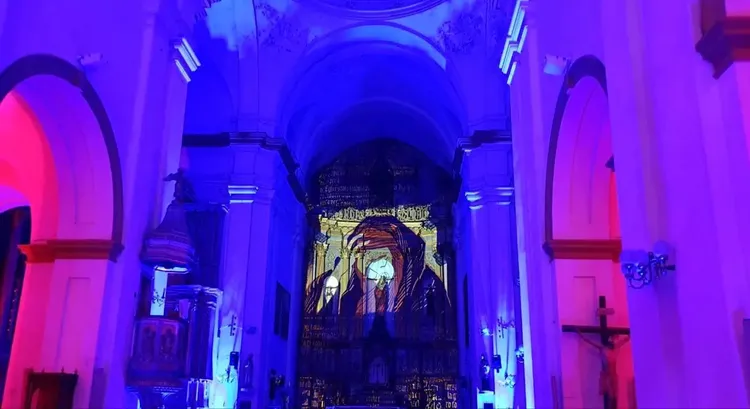Table of Contents
Lighting in churches is far more than a technical consideration; it is an essential element of the architectural and spiritual vision, designed to highlight the sacred space and cultivate an atmosphere of prayer and awe.
Lighting is distinctly categorized into interior and exterior illumination, each differing in function and aesthetic approach.
Exterior illumination aims to make the church visible from afar, accentuating its architectural forms and silhouette while establishing it as a landmark and spiritual center. It is commonly applied to domes, facades, bell towers, and entrance areas. Warm white light is typically employed, gently highlighting details without altering the historical character of the building. Luminaires are positioned to avoid dazzling pedestrians or drivers, often integrated into the landscape or mounted on specialized supports with precise directionality. The primary objective is to evoke a solemn yet understated impression of the church at night, steering clear of excessive ornamentation and preserving a sense of dignity and serenity.
A lighting management system is vital for controlling exterior illumination, creating the appropriate ambiance, and efficiently organizing the light environment. Its core function is to regulate lighting in a way that aligns with the church’s spiritual purpose, enhances architectural beauty, avoids distracting from prayer, and remains user-friendly and energy-efficient.
In practice, this requires the system to enable smooth and precise light control based on the time of day, type of service, number of worshippers, or the church calendar. This necessitates multiple pre-programmed modes that switch according to the calendar, alongside the option for manual overrides.
For instance, a morning service may call for one level of brightness, an evening service another, and nighttime a more subdued, intimate setting. Special occasions—such as holidays, processions, or memorial services—may require distinct lighting scenarios.
Modern lighting management systems, such as MONARQ equipped with MONARQ or MONARQ Mini controllers, allow these settings to be programmed in advance, activated automatically, or adjusted manually via physical buttons or triggers, all while remaining intuitive to use. Another critical feature is the system’s respect for the church’s physical integrity. Many churches are architectural monuments where installing additional control cables is prohibited. Devices like PowerGate and RadioGate, designed for outdoor use, transmit control signals via power lines or radio channels, often providing the only feasible method to manage lighting without damaging the church’s exterior.
Interior light for church
Interior illumination, by contrast, focuses on fostering an atmosphere of solitude and spiritual focus. The emphasis here is on soft, diffused light that avoids harsh shadows.
The church’s architecture and interior guide light distribution: the altar, iconostasis, vaults, frescoes, and choir areas each demand a tailored approach. Light is often concealed behind cornices or within niches to keep the focus on prayer. Illumination highlights icons without causing glare on glass surfaces. Many churches incorporate candles, oil lamps, and other traditional light sources, which lend a vibrant, “breathing” quality to the lighting, echoing ancient traditions.
With LEDs now prevalent in lighting, smooth control requires specialized drivers like LEDgate, which supports 16-bit dimming control optimized for gradual brightness adjustments. These devices eliminate flickering during brightness changes, ensuring exceptionally smooth transitions at low illumination levels.
The symbolism of light in religious culture is also significant: in a church, light is not merely a physical phenomenon but a symbol of Divine presence.
Thus, lighting design demands not only technical expertise but also reverence for the spiritual essence of the space. This is particularly critical in churches classified as architectural monuments, where any modifications require approval from restorers and church authorities.
In summary, exterior illumination makes the church visible and recognizable, while interior illumination aids worshippers in attuning to prayer and spiritual experience. Both elements must work in harmony to create a unified image—radiant, reverent, and cohesive.

